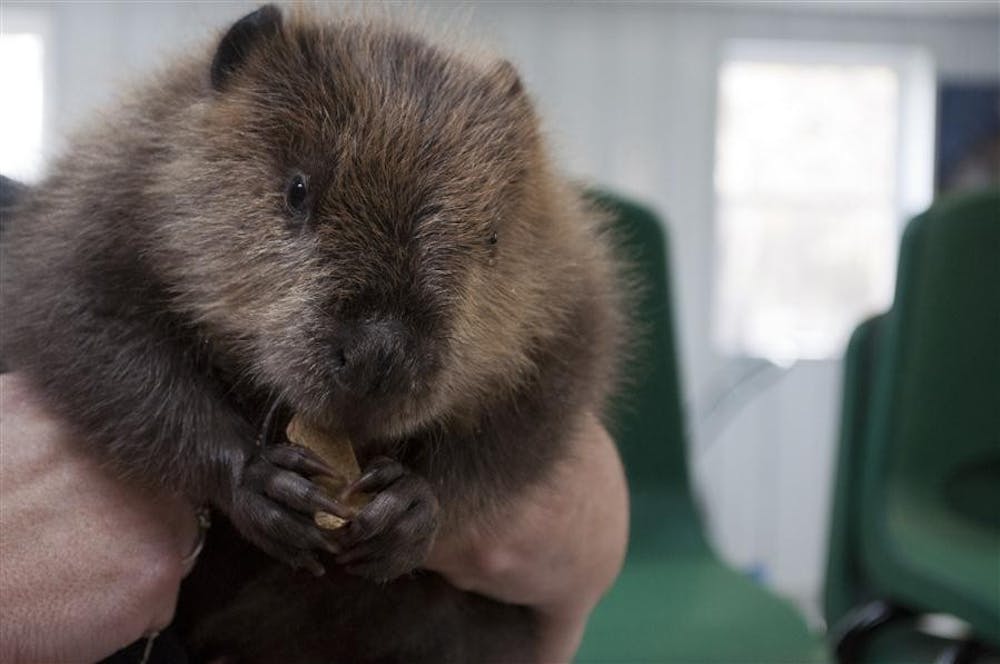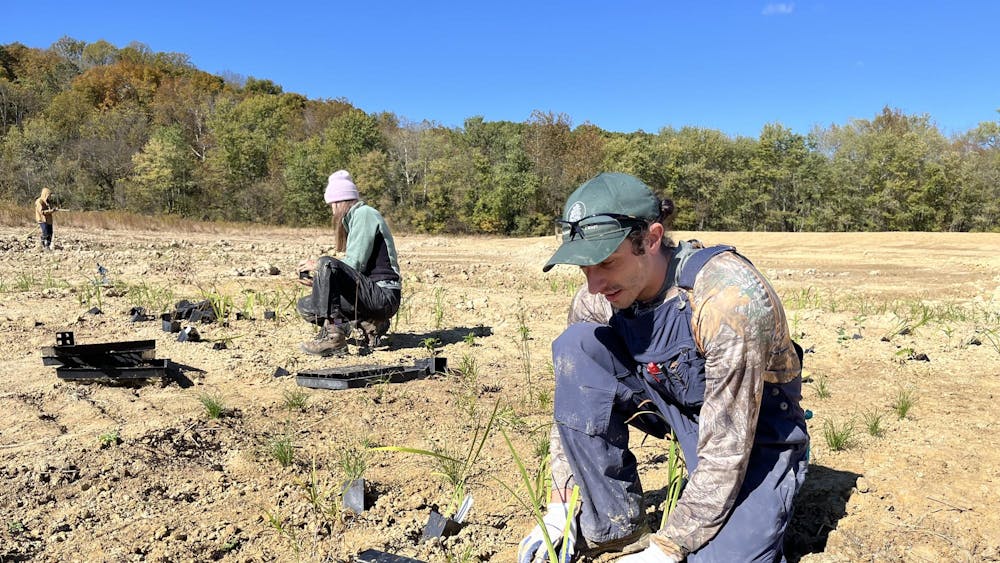Lily, a 6-month-old beaver, grasped her stuffed beaver toy, her black nose sticking out of her cage.
She was found lying on her dead mother in May in northern Indiana, near Michigan. The baby beaver was taken in by WildCare Inc., a wildlife rehabilitation center in Bloomington, where she will undergo two years of rehabilitation for metabolic bone disease.
For now, center volunteers have taken the place of Lily’s mom, giving her “beaver lessons” in smacking her tail and collecting branches while feeding her broccoli and blueberries, her favorite foods.
“We try to hold her close and talk to her and teach her things she’s going to need for the wild,” Center Manager Jennifer Cunningham said. “She’s spoiled rotten.”
Lily is one of the 2,007 animals admitted to the wildlife center this year, a record number that is triple the number of intakes from 2010, Cunningham said. This increase, matched with a decline in funding, has caused the center to temporarily close its doors to animals.
The increased intake is attributed to the early spring and summer’s hard-hitting drought, which led to dehydration and emaciation in several wild species, Cunningham said. An upward trend in diseases like West Nile Virus and a hemorrhagic disease found in deer called bluetongue also contributed.
“With the increase in intakes and (the animals) staying longer because of illness, it depleted what we had,” Cunningham said.
The center, a non-profit organization with a $95,000 annual budget, receives no federal funding or tax money and relies entirely on community donations, Cunningham said. A decrease in donations also contributed to the financial struggles, which led the center to place a hold on intakes.
“We were very scared when we looked in our freezer and realized how low we were on food,” Cunningham said. “The money wasn’t there to buy more.”
It costs an average of $70 to care for each animal in the center. The center was required to give several of its birds a vaccination for the West Nile Virus, costing an additional $2,000 to vaccinate its 13 baby Eastern Screech Owls.
“With the outpour of outreach for the community, we have paid off our debt for 2012,” Cunningham said. “However, it does not leave us with much for the beginning of 2013.”
During the last two weeks, due to an increased awareness in the community, the center received roughly $10,000 in donations, mostly from one donor, volunteer Lane
Vargas said.
Vargas is in charge of organizing WildCare’s fourth annual Holiday Bazaar on Dec. 1, which will serve as an important fundraiser. Cunningham said she hopes to plan additional fundraisers and seek out any grants that could improve funding.
WildCare Inc. currently receives a $3,500 stipend from the City of Bloomington, mainly due to the way the center often receives animals from the City of Bloomington Animal Care and Control shelter, Cunningham said.
The animal shelter, a member of the city’s Department of Public Works, is provided with year-long city funding, while the rehabilitation center is not.
Cunningham said that although WildCare Inc. has had a solid relationship with the local Department of Natural Resources, the state-wide DNR has not proved as supportive.
“The DNR likes to drop off animals to us, but they never make a donation,” Cunningham said. “A lot of them feel like we should just leave (wild animals) be.”
To avoid another intake influx, the center will set quotas for the number of animals they can accept from each species next year, Vargas said.
The center hopes to begin accepting animals again in about two weeks, starting by only taking endangered animals, Cunningham said.
Bats are one of several endangered species cared for by WildCare Inc., Cunningham said. Although the center just released its last two bats, by the end of the month, the number of bats in the region that will need rehabilitation will rise.
The species is hit hard by daylight savings, Cunningham said. As the days get darker earlier, there is increased traffic on roads during normal eating times for bats, causing increased deaths by vehicle.
Cunningham emphasized that wildlife rehabilitation centers like WildCare do more than simply help care for sick, injured and orphaned animals — they also have a positive effect on the local environment.
“If you don’t have bats you’ll have an overpopulation of bugs. If you don’t have owls or hawks, you’ll have an overpopulation of rodents,” Cunningham said. “They make the eco-system run. Dogs and cats don’t.”
Vargas agrees that many people think humans should just let nature run its course.
“Ninety percent or more of animals we get are harmed by humans,” Vargas said. “I don’t really think that’s nature running its course. It’s worth the effort to me.”
Wildlife center admits 2,007

Get stories like this in your inbox
Subscribe





